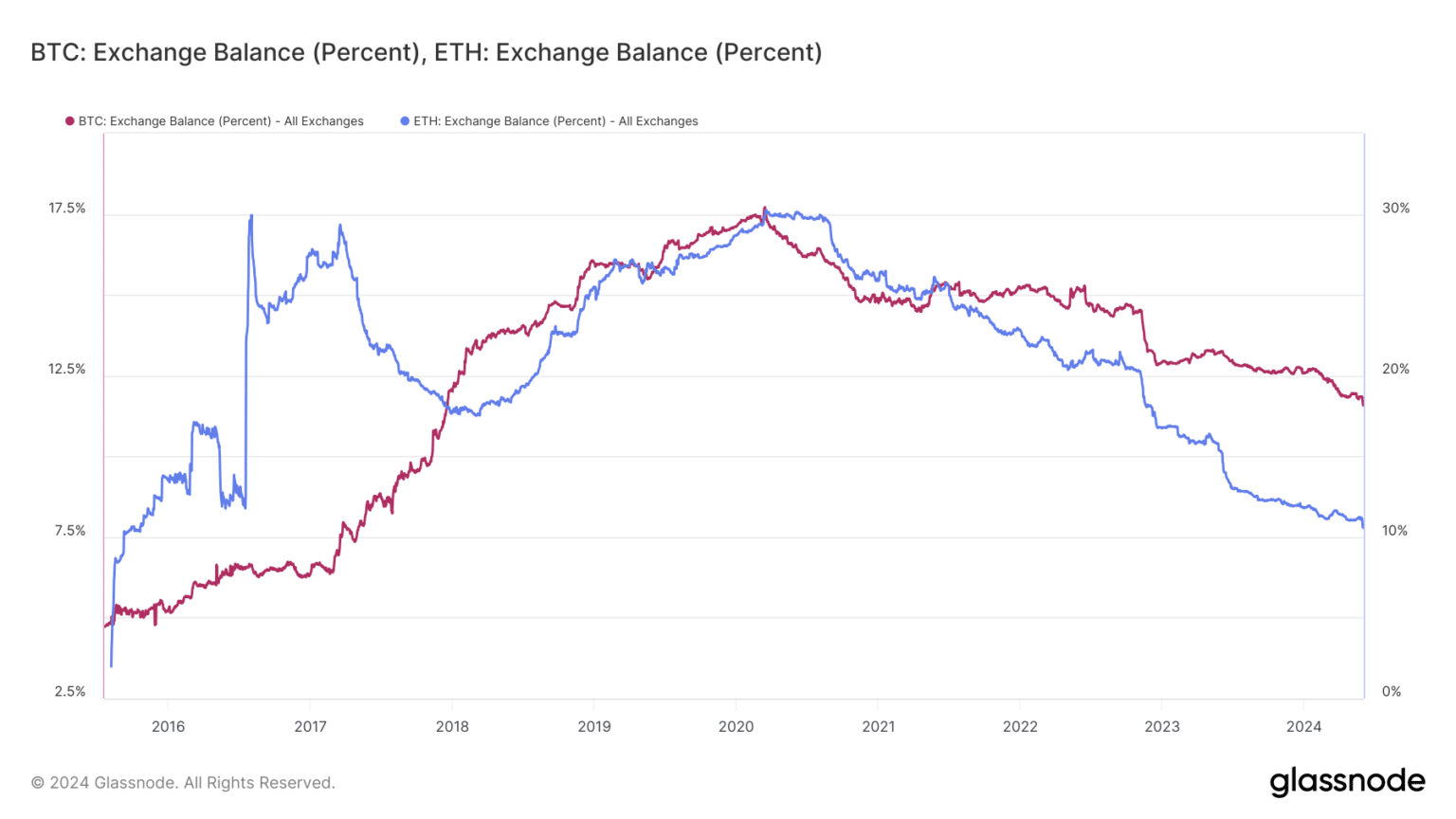
Line chart: BTC vs ETH exchange balance percentages, 2015–2024
If you’re planning to rotate part of your Bitcoin position into Ethereum for portfolio balance or dApp exposure, you can exchange BTC to ETH in minutes. Below is a practical guide that shows when a BTC to ETH move makes sense, how to do it safely, and what to check so you don’t overpay on fees or lose time on stuck transactions.
Who is this for? Holders considering Bitcoin to Ethereum conversions (BTC ETH) for diversification, staking/yield strategies, or to pay ETH-based gas and interact with DeFi/NFTs.
Why Rotate From Bitcoin to Ethereum?
Different roles. Bitcoin is the dominant store-of-value asset; Ethereum powers smart contracts and most DeFi/NFT activity. A Bitcoin to ETH allocation can add tech/growth exposure without fully exiting BTC.
Utility needs. If you need ETH for gas (transactions, DeFi, L2 bridges), a quick swap BTC to ETH gives you a spendable ETH without touching a bank card.
Risk management. Some traders rebalance after large BTC moves, shifting a slice into ETH to maintain target weights (e.g., 70/30 or 60/40 across majors). Rebalancing is not about “calling tops,” it’s about keeping risk in line.
How to Swap BTC to ETH (step-by-step)
Below is a simple flow that works whether your goal is a one-off Bitcoin to Ethereum move or a recurring rebalance.
1) Decide your rate type: floating vs. fixed
- Floating rate: you get the market rate at execution time. Usually better during calm markets.
- Fixed rate: locks the rate for a short window (helpful in volatility). There’s a small premium for certainty.
2) Prepare your ETH receiving address
- For self-custody: use your wallet’s Ethereum mainnet address (starts with 0x…).
- Double-check you are not pasting an exchange “deposit memo/tag” by mistake — Ethereum addresses don’t use destination tags like XRP or XLM.
Quick check: Send a tiny test first if you’re moving a large amount.
3) Start the exchange
Open the crypto wallet and choose BTC to ETH. Enter the amount to convert and paste your ETH address. Confirm the details and generate the deposit address.
- Exchange page: exchange BTC to ETH
4) Send BTC and wait for confirmations
Send your BTC to the provided deposit address. The network will need a few Bitcoin confirmations before the swap proceeds. Then the crypto wallet sends the output in Ethereum to your destination address.
Tip: Keep your wallet open and connected until the transaction is broadcast and confirmed.
5) Verify receipt on Ethereum
Your Ethereum should land in your wallet shortly after the BTC side confirms and the trade executes. If your wallet shows no balance, click “refresh” or search the address in a block explorer. (Some wallets require adding ETH as a tracked asset.)
Timing: when Does a BTC to ETH move Make Sense?
Consider these practical triggers:
- Utility need: You plan to use an app on Ethereum/L2 this week and need gas. Convert a small buffer so you’re not forced to buy ETH during a spike.
- Rebalance rule: If BTC outperformed and your BTC share grew above target (say 60% to 70%), a BTC to ETH rotation trims risk without exiting crypto.
- Catalyst view (advanced): Upcoming Ethereum upgrades, L2 activity, or on-chain flows may justify a partial rotation. Have a thesis and a stop — don’t chase headlines.
BTC/ETH weekly ratio chart, strong uptrend through 2024–2025.
Pro tip: Check costs before you move. Compare percent fee + implied spread and estimate Ethereum gas you’ll spend after receiving funds. Small changes in slippage can matter on big tickets.
Costs and Confirmations (what to expect)
- Network fee (BTC side): Paid from your wallet to broadcast the deposit. Higher when mempools are congested.
- Exchange fee/spread: The rate you get at execution (floating) or the locked fixed rate.
- ETH gas after swap: You’ll pay gas when you later move or use that ETH (e.g., to a DeFi protocol).
How to minimize costs:
- Prefer floating when markets are calm; choose fixed when the market is jumpy and you value certainty.
- Avoid “rush hour” mempool congestion for BTC deposits if you’re fee-sensitive.
- Batch: if you know you’ll need ETH soon for multiple actions, convert once instead of many tiny swaps.
Prefer a walkthrough? Watch: “Benefits of fast cryptocurrency exchange online” for a concise look at how the process works and which settings to choose.
Live Price Check (before you hit “Swap”)
Spot price moves change your outcome. If you’re timing an entry, verify current levels first:
- BTC price today — check intraday swings before converting.
Security Right Practices For BTC to ETH swaps
- Verify addresses each time. Paste-compare the first/last 6–8 characters.
- Beware look-alike tokens. You need native ETH on Ethereum mainnet, not wrapped tokens on other chains.
- Use your own device. Avoid public machines; keep your OS and wallet updated.
- Test first. Large converts? Send a small test transaction to the same ETH address.
- Record the transaction IDs. Save your BTC TXID and the resulting ETH TXID for support/audit.
“Slow is smooth, smooth is fast.” A 30-second address check beats hours of recovery attempts.
FAQ
Is there a minimum or maximum for a swap BTC to ETH?
Minimums depend on network fees and liquidity. If a tiny amount gets eaten by fees, consider aggregating more BTC first.
How long does a Bitcoin to Ethereum exchange take?
It depends on BTC confirmations and current network load. After enough confirmations, Ethereum delivery is typically fast.
Can I send BTC from an exchange and receive ETH to self-custody?
Yes — just make sure the ETH address is yours (self-custody or another exchange account that supports ETH deposits on Ethereum mainnet).
What if I pasted the wrong network address?
Crypto transactions are irreversible. If you suspect an error, contact support immediately with both TXIDs. Prevention is key.
Summary
Rotating a slice of BTC into Ethereum can add utility and growth exposure to your portfolio. Decide why you’re moving (utility, rebalance, thesis), pick floating or fixed based on volatility, verify the address, and keep your TXIDs.






